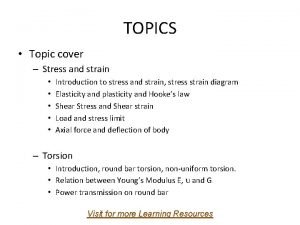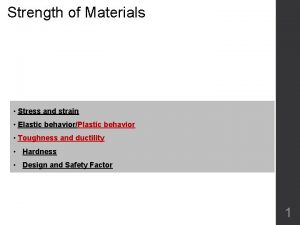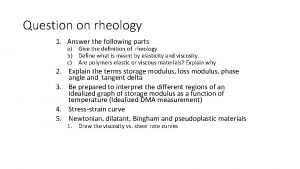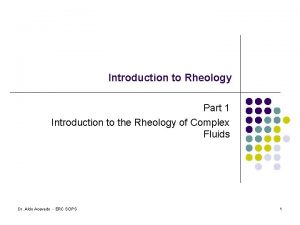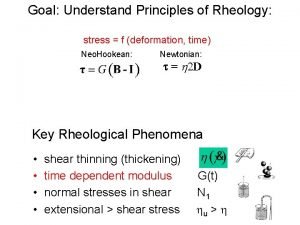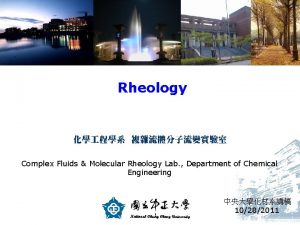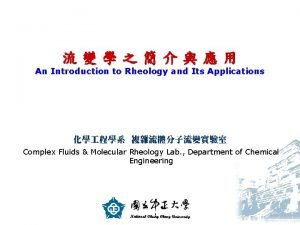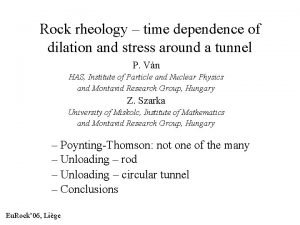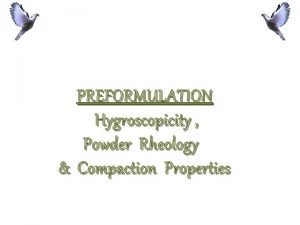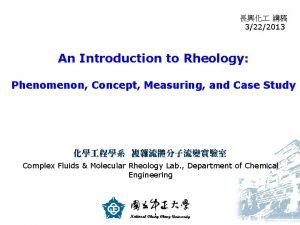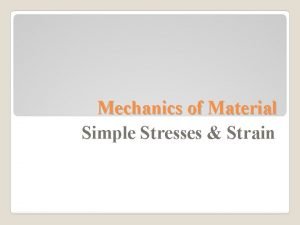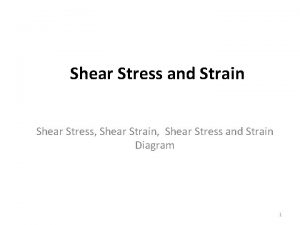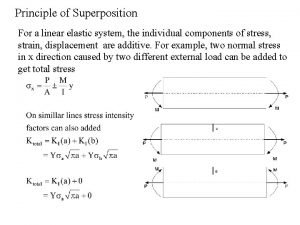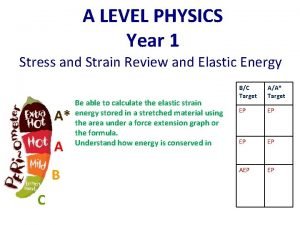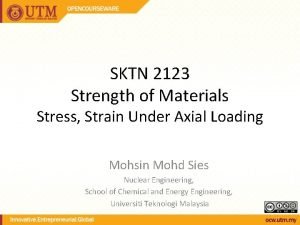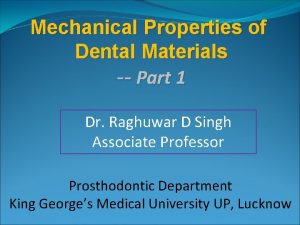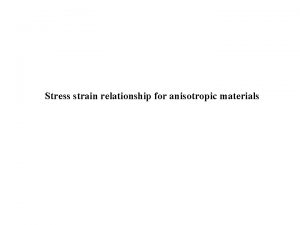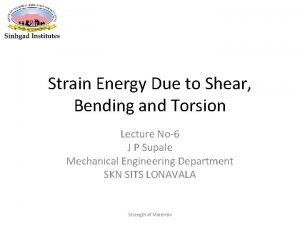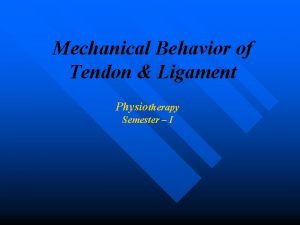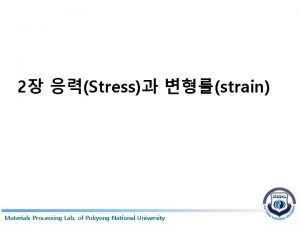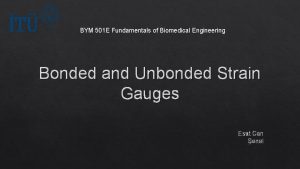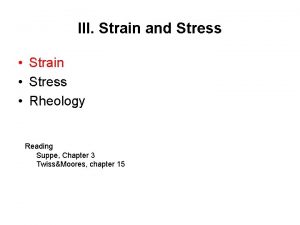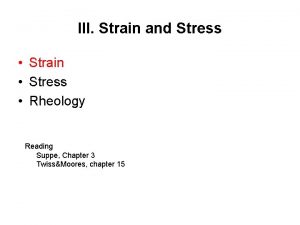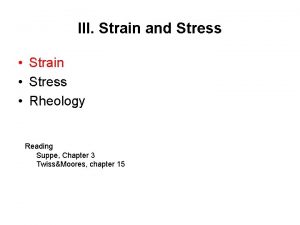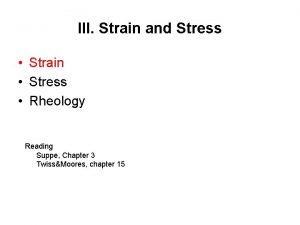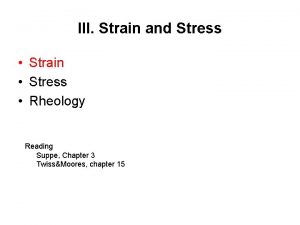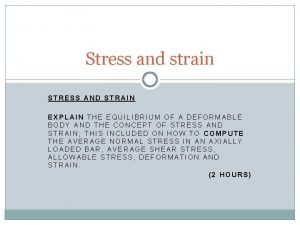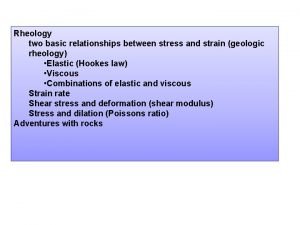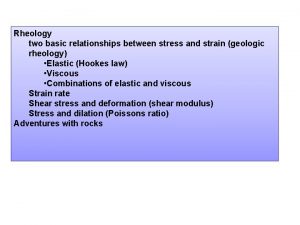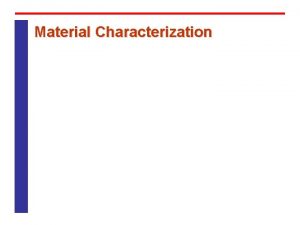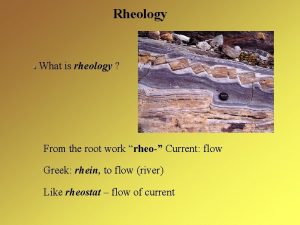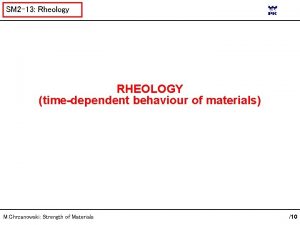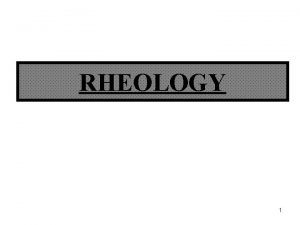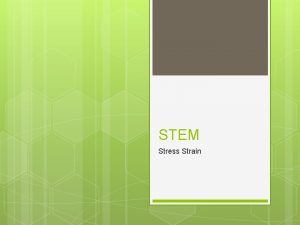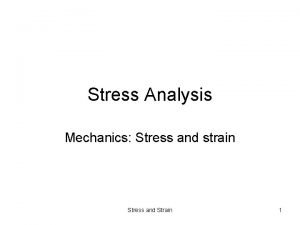III Strain and Stress Strain Stress Rheology Reading



























































- Slides: 59

III. Strain and Stress • Strain • Stress • Rheology Reading Suppe, Chapter 3 Twiss&Moores, chapter 15



Photomicrograph of ooid limestone. Grains are 0. 5 -1 mm in size. Large grain in center shows well developed concentric calcite layers.

Thin section (transmitted light) of deformed oolitic limestone, Swiss Alps. The approximate principal extension (red) and principal shortening directions (yellow) are indicated. The ooids are not perfectly elliptical because the original ooids were not perfectly spherical and because compositional differences led to heterogeneous strain. The elongated ooids define a crude foliation subperpendicular to the principal shortening direction. Photo credit: John Ramsay. http: //www. rci. rutgers. edu/~schlisch/structureslides/oolite. html

Deformed Ordovian trilobite. Deformed samples such as this provide valuable strain markers. Since we know the shape of an undeformed trilobite of this species, we can compare that to this deformed specimen and quantify the amount and style of strain in the rock.


• Deformation of a deformable body can be discontinuous (localized on faults) or continuous. • Strain: change of size and shape of a body

III. Strain and Stress • Strain – Basics of Continuum Mechanics – Geological examples Additional References : Jean Salençon, Handbook of continuum mechanics: general concepts, thermoelasticity, Springer, 2001 Chandrasekharaiah D. S. , Debnath L. (1994) Continuum Mechanics Publisher: Academic press, Inc.

Basics of continuum mechanics, Strain A. Displacements, trajectories, streamlines, emission lines 1 - Lagrangian parametrisation 2 - Eulerian parametrisation B Homogeneous and tangent Homogeneous transformation 1 - Definition of an homogeneous transformation 2 - Convective transport equation during homogeneous transformation 3 - Tangent homogeneous transformation C Strain during homogeneous transformation 1 - The Green strain tensor and the Green deformation tensor Infinitesimal vs finite deformation 2 - Polar factorisation D Properties of homogeneous transformations 1 - Deformation of line 2 - Deformation of spheres 3 - The strain ellipse 4 - The Mohr circle E Infinitesimal deformation 1 - Definition 2 - The infinitesimal strain tensor 3 - Polar factorisation 4 - The Mohr circle F Progressive, finite, and infinitesimal deformation : 1 - Rotational/non rotational deformation 2 - Coaxial Deformation G Case examples 1 - Uniaxial strain 2 - Pure shear, 3 - Simple shear 4 - Uniform dilatational strain

A. Describing the transformation of a body • Reference frame (coordinate system): R • Reference state (initial configuration): k 0 • State of the medium at time t: kt – – Position (at t), particle path (=trajectory) Displacement (from t 0 to t), Velocity (at time t) Strain (changes in length of lines, angles between lines, volume)

A. 1 Lagrangian parametrisation • Displacements • Trajectories • Streamlines

A. 1 Lagrangian parametrisation • Volume Change

A. 2 Eulerian parametrisation • Trajectories: • Streamlines: (at time t)

A. 3 Stationary Velocity Field • Velocity is independent of time NB: If the motion is stationary in the chosen reference frame then trajectories=streamlines

B. Homogeneous Tansformation • definition

Homogeneous Transformation • Changing reference frame

Homogeneous Transformation • Convective transport of a vector Implication: Straight lines remain straight during deformation

Homogeneous transformation • Convective transport of a volume

Homogeneous transformation • Convective transport of a surface

Tangent Homogeneous Deformation • Any transformation can be approximated locally by its tangent homogeneous transformation

Tangent Homogeneous Deformation • Any transformation can be approximated locally by its tangent homogeneous transformation

Tangent Homogeneous Deformation • Displacement field

D. Strain during homogeneous Deformation • The Cauchy strain tensor (or expansion tensor)

Strain during homogeneous Deformation • Elongation (or stretch) in the direction of a vector V : • Extension (or extension ratio), relative length change in the direction of a vector V:

Strain during homogeneous Deformation • Shear characterizes the change of angle between 2 initially orthogonal vectors • Shear angle ψ : Beware of confusing terminology: - Shear angle (angular shear strain): ψ - Engineering shear strain: γ=tan(ψ) - Tensor shear strain: tan(ψ)/2

Strain during homogeneous Deformation • Signification of the strain tensor components

Strain during homogeneous Deformation Cauchy strain tensor: Elongation along ei: Note that it is symmetrical Shear of (ei, ej) An orthometric reference frame can be found in which the strain tensor is diagonal. The SVD yields the 3 principal axes of the strain tensor. In which the Cauchy strain tensor simplifies to: Principal quadratic elongations (streches): λi 2 Principal elongations (stretch): λi Jacobian:

Strain during homogeneous Deformation • The Green-Lagrange strain tensor (strain tensor)

Strain during homogeneous Deformation • The Green-Lagrange strain tensor

Strain during homogeneous Deformation • Rigid Body Transformation

Strain during homogeneous Deformation • Rigid Body Transformation

Strain during homogeneous Deformation • Polar factorisation

Strain during homogeneous Deformation • Polar factorisation

Strain during homogeneous Deformation • Polar factorisation

Strain during homogeneous Deformation • Pure deformation: The principal strain axes remain parallel to themselves during deformation

D. Some properties of homogeneous Deformation

Some properties of homogeneous Deformation • The strain tensor is uniquely characterized by the strain ellipsoid (a sphere with unit radius in the initial configuration)

Some properties of homogeneous Deformation • The strain tensor is uniquely characterized by the strain ellipsoid (a sphere with unit radius in the initial configuration)

Some properties of homogeneous Deformation • The strain tensor associated to an homogeneous transformation does not define uniquely the transformation (the translation and the rotation terms remain undetermined)

Homogeneous Transformation x= R S X + c c x 1=S X x 2=R x 1 x = x 2+c

Classification of strain The Flinn diagram characterizes the ellipticity of strain (for constant volume deformation: with

E. Infinitesimal transformation

E. Infinitesimal transformation Infinitesimal strain tensor

Infinitesimal transformation

Relation between the infinitesimal strain tensor and displacement gradient

The strain ellipse NB: The representation of principal extensions on this diagram is correct only for infinitesimal strain only

Rk: For an infinitesimal deformation the principal extensions are small (typically less than 1%). The strain ellipse are close to a circle. For visualisation the strain ellipse is represented with some exaggeration

Relation between the infinitesimal strain tensor and displacement gradient

F. Finite, infinitesimal and progressive deformation – Finite deformation is said to be non-rotational if the principle strain axis in the initial and final configurations are parallel. This characterizes only how the final state relates to the initial state – Finite deformation of a body is the result of a deformation path (progressive deformation). – There is an infinity of possible deformation paths to reach a particular finite strain. – Generally, infinitesimal strain (or equivalently the strain rate tensor) is used to describe incremental deformation of a body that has experienced some finite strain – A progressive deformation is said to be coaxial if the principal axis of the infinitesimal strain tensor remain parallel to the principal axis of the finite strain tensor. It characterizes the progressive deformation.

Rotational vs non-rotational deformation If A and B are parallel to a and b respectively the deformation is said to be non-rotational (This means R= 1)

Non-rotational transformation A a B b (a//A and b//B) x= S X + c

Non-rotational non-coaxial progressive transformation a Stage 1: b A Stage 2: B

Uniaxial strain NB: Uniaxial strain is a type a non-rotational deformation (pure strain)

Pure Shear NB: Pure shear in is a type a non-rotational deformation (plane strain, λ 2=1)

Simple Shear NB: Simple shear is rotational (Plane strain, λ 2=1)

(NB: These are two example of stationnary transformations)

Progressive simple Shear Progressive simple shear is non coaxial

Progressive pure shear is a type of coaxial strain
 Stress and strain reading outline
Stress and strain reading outline While reading activities
While reading activities Elastic strain and plastic strain
Elastic strain and plastic strain Elastic strain and plastic strain
Elastic strain and plastic strain Rheology questions
Rheology questions Hamlet act iii scene iii
Hamlet act iii scene iii Scale of flowability
Scale of flowability Rheology in pharmacy
Rheology in pharmacy What is rheology in pharmacy
What is rheology in pharmacy Introduction to rheology
Introduction to rheology Rheology
Rheology Dilatant flow is reverse phenomenon of
Dilatant flow is reverse phenomenon of Blood rheology definition
Blood rheology definition Rheology lab
Rheology lab Cox-merz rule
Cox-merz rule Aerc rheology
Aerc rheology Rock rheology
Rock rheology Define hausner ratio
Define hausner ratio An introduction to rheology
An introduction to rheology Hookes law
Hookes law Mechanics of material
Mechanics of material St venant principle
St venant principle The joint is fastened together using two bolts
The joint is fastened together using two bolts Principle of superposition in stress and strain
Principle of superposition in stress and strain Strain energy formula
Strain energy formula St venant principle
St venant principle True fracture strain
True fracture strain Yield strength dental materials
Yield strength dental materials Stress strain coping support model
Stress strain coping support model Orthotropic material examples
Orthotropic material examples Strain energy in torsion
Strain energy in torsion Slidetodoc
Slidetodoc Stress strain curve physiotherapy
Stress strain curve physiotherapy Selbstregulation
Selbstregulation Plane stress plane strain
Plane stress plane strain Chapter 10 stress responses and stress management
Chapter 10 stress responses and stress management What are the aims of teaching reading?
What are the aims of teaching reading? Types of reading
Types of reading Intensive reading and extensive reading
Intensive reading and extensive reading For adult
For adult What is intensive reading
What is intensive reading What is the definition of axial stress
What is the definition of axial stress St. louis
St. louis Edb net
Edb net Critical reading active process of discovery
Critical reading active process of discovery Aluminum and iron iii oxide balanced equation
Aluminum and iron iii oxide balanced equation Differences between george washington and king george iii
Differences between george washington and king george iii Double replacement example
Double replacement example Richard iii and looking for richard
Richard iii and looking for richard John adams vs thomas jefferson venn diagram
John adams vs thomas jefferson venn diagram Resolution no. 435 series of 1997 summary
Resolution no. 435 series of 1997 summary Act 3 of romeo and juliet
Act 3 of romeo and juliet Romeo and juliet jeopardy
Romeo and juliet jeopardy What punishment did the prince give romeo
What punishment did the prince give romeo Which event from acts ii and iii
Which event from acts ii and iii Bonded and unbonded strain gauge
Bonded and unbonded strain gauge Anomie and strain
Anomie and strain Wppsi-iv interpretazione punteggi
Wppsi-iv interpretazione punteggi What is a class iii laser
What is a class iii laser Iii rozbiór polski mapa
Iii rozbiór polski mapa
